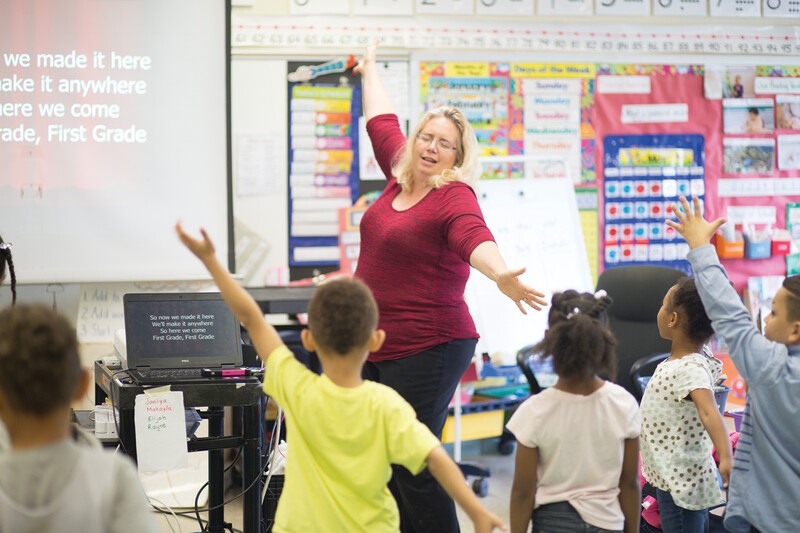I've got an embarrassing confession to make: Until recently, I wasn't convinced that differentiating learning opportunities for students really mattered. Like many teachers, I would deliver one lesson each day, keeping my fingers crossed that I met everyone's needs. And even though I've always had a sense for the strengths and weaknesses of my individual students, I rarely drew on that knowledge to make specific changes in instruction or assignments.
The primary reason for my inability to embrace differentiation as a teacher was that, until recently, I'd never experienced differentiation as a learner. Like most practitioners, I've spent too much professional development time sitting in lectures delivered to entire faculties. No one offered preassessments, tiered lessons, or learning contracts to my colleagues or me. Instead, we plodded through courses designed to meet the needs of the majority. In fact, the structure of professional development programs in most schools sends conflicting messages about the importance of meeting learners where they are.
Differentiation has grown on me in the past 18 months, though, thanks to my experiences using the online networking tool Twitter. Twitter makes it easy to post short (140-character maximum), public, text-based messages to the Web—messages that any interested follower can see and respond to.
Although many Twitter users post personal messages that might be described as "digital noise" (such as "Having Chinese takeout for dinner"), teaching professionals have found ways to use Twitter to share resources and lend quick support to peers with similar interests. For educators who use this tool to build a network of people whose Twitter messages connect to their work, Twitter becomes a constant source of new ideas to explore.
Finding Someone to "Follow"
I began my work with Twitter by creating a free account, which anyone with an Internet connection can do by visiting http://twitter.com. I then started following the updates of Sheryl Nussbaum-Beach (@snbeach), a Teacher Leaders Network colleague and digital learning expert. Each time I signed into Twitter, I'd automatically see any thoughts that Sheryl had posted, sometimes including links to articles she was reading.
Although Sheryl's messages were not intended for me alone—all of her Twitter followers could see her posts—most were valuable to me because Sheryl and I are both interested in the changing nature of learning in the 21st century. We each study the kinds of skills students will need to be successful in tomorrow's world and the ways digital tools can facilitate meaningful experiences in today's classrooms. Exploring her Twitter posts challenged my thinking and led me to great resources without having to spend hours searching. Even as my Twitter network has grown, Sheryl's posts continue to help me. Just today, she shared a link to a collection of resources on teaching second languages that I can't wait to explore.
Next, I started following the Twitter messages shared by many of the creative educators I found on the Twitter4Teachers wiki, seeking the same kinds of people I like to exchange ideas with in real life. I focused on finding middle school language arts and social studies teachers or teachers interested in technology, knowing that people with my interests were likely to point me toward resources I could use.
I also followed Twitter users who were recommended by digital peers or whom I knew in person. Each of their updates appeared automatically on my Twitter homepage. I could look inside the minds of motivated peers to learn about the new projects they were undertaking, the research reports they were studying, and Web sites they were exploring. As my comfort with Twitter grew—a process that took a few months, as is typical for new users—I became an active contributor to this knowledge network.
I'm constantly jazzed by my Twitter network because I have easy access to a stream of customized information and ideas that motivate me—one characteristic of differentiated learning. This information is customized because I follow only Twitter posters who discuss topics I'm eager to learn about. Although I can't read every message generated by the 200 education professionals whose updates I now follow, I skim through posts for 20 minutes each morning and afternoon.
Using the Reply and Direct Message options, I join conversations with individual members of this digital community, offering suggestions, asking questions, and celebrating successes. As with most digital conversations, I can either make my replies visible to everyone who's following my updates or target private replies to certain individuals.
I now turn to Twitter friends for help in the same way that I turn to the teachers on my hallway. Recently, a friend in my Twitter feed pointed me to a great strategy for structuring classroom discussions, a practice I'd been struggling with.
Opportunities for Customization
What lessons have I learned from Twitter? First, I finally understand how much differentiated learning matters. My own motivation levels have skyrocketed, I'm accessing ideas connected to my professional interests, and I've taken ownership of my own learning.
This has me convinced that we can use digital tools to differentiate learning for students, too. Although Twitter may not be appropriate in all situations— elementary students would struggle to build meaningful networks of peers, and schools would have to actively address Internet safety—it's being used successfully by several inventive high school teachers. Shelly Blake-Plock, for example, a Maryland Latin and art history teacher, is integrating Twitter into research, discussion, and vocabulary work in his classroom. Blake-Plock shares ideas on using Twitter in the classroom in this entry on his blog, Teach Paperless.
Teachers must identify how applications like Twitter can facilitate their learning. Digital opportunities to connect with new content and communities can accelerate learning for every student—but only after teachers become efficient digital learners, too.







